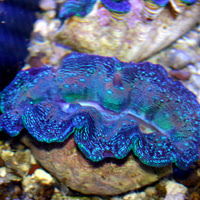
Just got back from MACNA XIX in Pittsburgh, and I would like to congratulate the Pittsburgh Marine Aquarium Society for hosting and outstanding conference.
The next few Blog topics will be about some of the Seminars and Events that I attended at this years MACNA conference.
One of the seminars that I found really interesting was the Giant Clam presentation by James Fatherree. James is the author of the book “Giant Clams in The Sea And The Aquarium”and gave a presentation based upon some of the most common questions that he is asked about Giant Clams, and the Answers to those questions.
How much light do I need to keep a Tridacna Clam? This is a question that I am commonly asked about clams from our customers here at TFP, and one of the questions that James Fatherree addressed during his presentation. How much light is needed is probably the most important question to be answered, in regard to keeping giant clams in the aquarium. Giant clams receive as much as 100 percent of their nutrition from light that provides energy for photosynthesis for their symbiotic algae (zooxanthellae). How much light depends much upon the species of clam that you are trying to keep. Clams are found in the oceans throughout a wide range of depths in the tropical Pacific Ocean, from near the oceans surface, down to more than 25 meters (83 feet). Some species are only found in fairly shallow water, like the Tridacna crocea, which require very intense lighting. Others Giant Clam species such as T. maximaand T. squamosa, are found at depths of up to 15 meters (50 feet) and required strong lighting. Another species of Giant Clam that is commonly kept in the aquarium trade, T. derasa, is found at depths of up to 25 meters (83 feet) and require moderate lighting. All these depths are extreme maximums, under ideal conditions. The vast majority of clams found in the wild are found at much shallower depths than these maximum. All species of Clams that are grown in commercial farms are typically grown in shallow pools or raceways under intense lighting.
The best answer to this question is that there is no such thing as too much light for Clams in the aquarium. Deeper water species, like Tridacna derasa and Hippopus hippopus, will tolerate fluorescent lighting in very shallow aquariums, or high output T-5, VHO, or Compact Fluorescent lighting in aquariums up to about 24” deep. All other clams should only be kept under the intensity of Metal Halide lighting. The deeper the aquarium the higher wattage metal halide light should be used, in general the more light you can provide, the higher your chances for long term health and growth.
For more great information on Giant Clams check out James Fatherree’s book “Giant Clams in The Sea And The Aquarium”
Hope this sheds some light on questions that you may have had about clams, until next time.
Dave
 That Fish Blog – Aquarium Advice and Information
That Fish Blog – Aquarium Advice and Information


I use t5 lighting and was wondering if there was a reccomendation for specific wavelength or kelvin temperature. Always see intense lighting but not sure what that means. Is it just a high par rating ? Not sure how they all fit together
Mike, the wavelength or kelvin temperature choices for HO T5 lighting are wide ranging, choosing the correct bulbs for your aquarium will depend both on the types of plants or animals that you are keeping, and also on your personal color preferences. A combination of daylight (6700K-20000K) and blue/actinic (420-460nm) will provide the spectrum of lighting required for most photosynthetic marine animal or plants. There are some other bulbs available that are pink and purple, that are mostly for color enhancing and asthetics, as well as providing light. As far as PAR values and intensity, that is more of a function of the number of bulbs/fixtures that you use, and the quality of the bulbs and reflectors in your fixture. Generally, for T5 lighting, what would be considered intense lighting would be a 4-6 bulb fixture (or more) depending upon the size and depth of your aquarium. Deep and large aquariums (over 24″) will require many more bulbs to be considered intense lighting than a small and shallow tank will. Hope that helps.
Dave